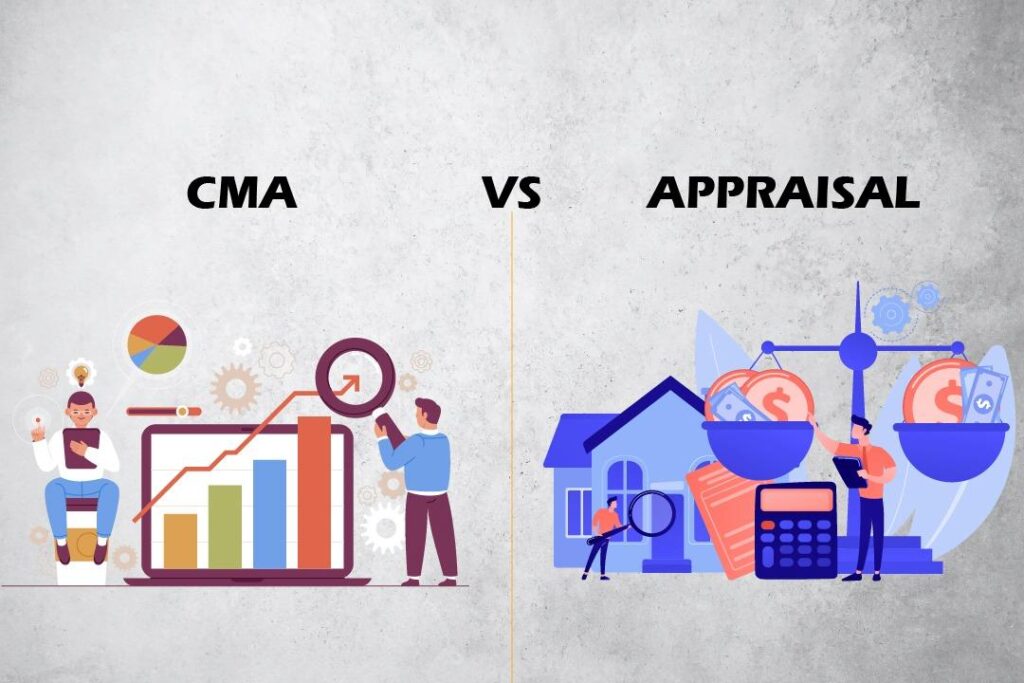Estimating the value of a house you’re looking to sell or buy can be challenging. A property’s
worth depends upon various factors while calculating the home’s entire value. Here
Comparative Market Analysis (CMA) comes into play and helps brokers and real estate
agents to meet their client’s requirements.
In this article, we’ll discuss what a Comparative Market Analysis is and how to perform it in 5
steps. In addition, we’ll also go through the differences between CMA and Appraisal. The
data included in the CMA report and the benefits that are provided by such information in
real estate are explained as well. So let’s dive into the Comparative Market Analysis and
learn how it works.
What is Comparative Market Analysis (CMA)?

A Comparative Market Analysis is considered to be one of the most effective methods that
real estate agents apply to figure out the value of a particular property. The property is
compared to other similar properties that have been sold recently in a nearby location.
Determining the worth of a property can be difficult considering multiple factors such as
location, age, condition, square footage, and many more factors that affect the worth of the
property.
Real estate agents create CMA reports for sellers to help them set prices for their houses
and it also helps buyers to make an offer. A Comparative Market Analysis makes it easier for
sellers to select the best listing prices for their properties. Here, the best doesn’t mean the
price of the property would be high but it means it would be an average price, not so much
high nor too low. Similarly, for buyers, CMA can help whether a house has a fair value and
set a competitive offer that is appealing to the seller on the other hand.
What is included in a CMA report?

Comparative Market Analysis performed by real estate agents and brokers requires a report
that will have all the important findings in it. Although there’s no standardized CMA report
however it’s important to include some specific details such as:
Description of the property:
A description of the property needs to be included in the CMA report that specifies elevation,
floor plan, and number of bedrooms as well as bathrooms in the property.
Address of the property:
A detailed address of the property and up to five comparables is required in the CMA report.
Square footage:
The square footage of each property is in a list that is intended to be compared.
The sales price of comparables:
The sales price of each comparable needs to be mentioned as well in the CMA report.
Adjusted sold price:
The information on the adjusted sold price per square foot of each comparable is added in
the CMA report.
Property’s price range:
A reasonable price range set for the property is mentioned in the CMA report.
Comparative Market Analysis VS Appraisal

There are two methods of finding the worth of the property, CMA and Appraisal. Both these
methods share many similarities but there are a few key differences in what approach they
adopt to arrive at the listing price of the property.
A CMA is performed by real estate agents with the help of information available to them on
the MLS (Multiple Listing Service). So, sellers on their own won’t be able to conduct a CMA
since among many other factors, access to the MLS is only exclusive to real estate agents.
A CMA compares the property to other neighboring properties that have been recently sold.
The data used in CMA is typically from the past three to six months.
On the other hand, Appraisal is carried out by a licensed appraiser. This appraisal is carried
out on behalf of the bank. The bank orders an appraisal of the property once a buyer applies
for a loan to purchase the property. Unlike real estate agents, bank appraisers have no
personal interest in selling the home. The only goal of the appraisers is to visit the property
determine the fair market value of the property and ensure that the bank isn’t lending more
money to the buyer of the property.
How to do a CMA in 5 steps?

Here’s a 5 steps guide on how to do CMA. It’s not only about comparing the prices of
recently sold properties but CMA involves the following basic steps which include:
Do a Neighbourhood Evaluation:
Neighborhood evaluation is an essential step in CMA. Real estate agents need to consider
the general quality of the neighborhood. They need to highlight the facilities available to
people in that specific area. Considering attractive blocks, amenities, and schools might
have a positive impact on the price of the property.
Review Property Details:
A real estate agent will visit the home to gather information. Some of the most important
information about the property that needs to be collected is the home’s size, age, condition,
construction, landscaping, layouts, and upgrades.
Find Comparables:
Another step real estate agents have to take is to find up to five comparable homes in the
neighborhood that have recently sold. For accurate CMA the comparable homes need to be
within one mile of the property. These agents have to focus on similar houses in terms of
square footage, bedrooms, bathrooms, and type of construction of these comparables. They
also need to pay attention to when these comparable houses were sold.
Adjust for differences:
In this step, a real estate agent will have to adjust for differences between the home and
each comparable house in the neighborhood. For example, if a comparable house has an
extra bedroom then in this case real estate agent would have to deduct an amount from the
comparable house for that extra bedroom for adjustment of differences.
Determine the sold price per square foot:
In this last step, the adjusted price of each comparable house is divided by its square
footage to find out the sold price per square foot. Another thing real estate agents need to do
is to add the sold price per square foot of all the comparable houses and divide by the total
number of comparables to get the average. In the end, this average is multiplied by the
square feet of the home to estimate its price.
Benefits of CMA for Real estate

Comparative Market Analysis provides significant benefits to real estate owners as well as
sellers and buyers. Some of the main advantages of CMA include:
Becoming Knowledgeable:
A Comparative Market Analysis makes it easier to make decisions. This is because CMA
provides knowledge about the listing prices, main selling features, types of houses, and the
duration in which other properties are staying and selling in the neighborhood. All pieces of
information make you knowledgeable and make it easier for you to make a decision.
Highlighting Profitable Areas:
CMA helps real estate agents find areas that are more likely to be popular and profitable in
the near future. Similarly, properties that are declining over time are also determined through
this process. This allows real estate agents to focus on more profitable areas.
Discover The Trends:
CMA is considered to be one of the most basic tools for determining the trends in real estate.
Real estate agents always need to be a couple of steps ahead of their competitors and CMA
is a great option to help them in exceeding their competitors. For example, let's suppose
two-story houses are selling much quicker than the single ones then real estate agents
would want to focus more on two-story houses.
Quick Selling:
A property in the market should sell faster because the more it remains in the market the
more difficult it becomes to sell it. Now, here CMA comes into play and provides the main
selling features of the properties that have sold in the neighborhood. These features would
help real estate agents to sell the property faster.
These are the main benefits of CMA in Real estate. Additionally, there are many more
advantages of this Method such as making leads while examining the neighboring properties
and getting knowledge about the recent prices in the market.
Conclusion
In conclusion, Comparative Market Analysis provides real estate with an opportunity to
gather information from neighboring recently sold houses and highlight the most profitable
features of the house that help them to sell it faster. However, depending on the market the
final price of the house might need to be tweaked slightly. For example, if the market is high
then prices are expected to be slightly higher than usual. On the other hand, if there are
many similar properties on the market the price needs to come down slightly to be
competitive.
FAQ’s
What is CMA in Real Estate?
A CMA is an estimate of a property’s price which is used by real estate agents to help sellers
set listing prices and buyers make competitive offers in the market. This analysis usually
considers the size, location, construction type, condition, style, and many other price-
defining factors.
Can I do my own CMA?
Yes, you can but in order to conduct your own Comparative Market Analysis you’ll have to
gather information about your house and recently sold houses in neighborhoods having
similar features. In the next step, you’ll be collecting data from different real estate sales
websites and making adjustments for differences between comparable houses and your
property. Then you’ll have to consider current market trends and estimate the price of your
property accordingly. However, it’s advisable to hire a real estate agent who’s more
experienced and has access to detailed information and market expertise.
Who can Prepare CMA?
A Comparative Market Analysis is prepared by real estate agents, appraisers, or brokers.
Their aim is to help sellers set listing prices and buyers understand the fair market value of
the house they’re interested in buying. These professionals are good at preparing CMA
because they have access to databases containing information about recently sold
properties, current listings, and other market details that are essential for the preparation of
Comparative Market Analysis.
